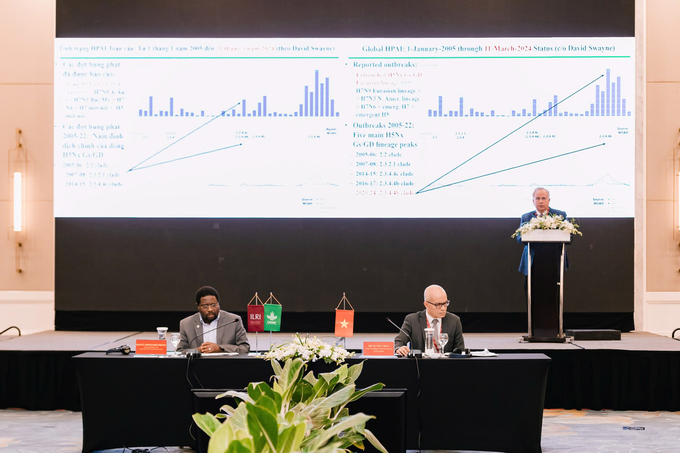June 25, 2025 | 01:38 GMT +7
June 25, 2025 | 01:38 GMT +7
Hotline: 0913.378.918
June 25, 2025 | 01:38 GMT +7
Hotline: 0913.378.918

Gregory Gray spoke about the H5N1 outbreak in cattle management as part of the Vietnam’s One Health Scientific Conference. Photo: Tung Dinh.
The International One Health Scientific Conference: International Practices and Lessons Learned for Vietnam was led by the Ministry of Agriculture and Rural Development (MARD) and the International Livestock Research Institute (ILRI) on October 16th. At the conference, Professor Gregory Gray spoke about the H5N1 outbreak in cattle management as part of the One Health approach operationalization in the USA.
Since February 2024, the United States has witnessed a rapidly spreading epidemic of highly pathogenic avian influenza (HPAI) among dairy cattle. Poultry flocks have also been heavily impacted, with outbreaks sweeping through farms. The H5N1 2.3.4.4b strain, responsible for these outbreaks, has infected 17 people so far: 6 dairy workers, 10 poultry workers, and 1 individual with no direct exposure to farms.
This rapid transmission across both animals and humans underscores the severity of the situation and raises concerns about its further spread. Currently, there’s no robust surveillance system in place to detect novel pathogens on livestock farms across the U.S.
Dr. Gray further shared the U.S. experiences with Vietnam Agriculture Newspaper.

VAN: The highly pathogenic avian influenza outbreak – how was it unusual, and what does it reveal about gaps in scientific understanding of diseases?
Dr. Gray: In February this year, we observed an unusual spillover of avian influenza into cattle. While cattle have previously been known to carry various strains of influenza, this was the first time we witnessed such large-scale infections. This particular strain was causing widespread illness not only in poultry but also in wildlife, especially among carnivores. It caught us off guard because we didn’t have proper surveillance for influenza in dairy cattle. Now, we’re working on developing effective monitoring systems, but it’s challenging to implement them without disrupting the dairy industry.
Although in theory, scientists and relevant agencies have time to respond to emerging threats, the approach is more reactive than proactive.
In areas affected by the outbreak, scientists also found increased numbers of dead birds around livestock operations. Infected cats often display severe neurological symptoms, along with nasal discharge and extensive lesions in critical organs, including the brain, lungs, and liver. These signs highlight the importance of paying close attention to wildlife and pets around farms, as they can offer early warning signals of the virus’s presence.
VAN: As scientists, how did you engage with the government in response to this outbreak?
Dr. Gray: Some livestock veterinarians were the first to notice that something strange was happening. They observed a drop in milk production in cattle, along with an unusual link to dead birds nearby. These early observations led them to suspect avian flu. Specimens were sent to a veterinary lab, which confirmed the presence of the virus in cattle. From there, academic institutions and government agencies launched investigations.
Several branches of the U.S. government, including the Department of Agriculture and the CDC, have been involved. Investigations are ongoing across various fronts - some focusing on farms, others on human cases, and even in wastewater monitoring, where H5N1 has been detected.

VAN: What’s the current status of the avian influenza virus spread, and what is at stake?
Dr. Gray: We are beginning to get a handle on the animal epidemic, or epizootic, but the virus continues to spread. In recent weeks, it has spread rapidly across California. There’s growing concern that migrating birds will carry the virus to new areas as they move across the U.S. this winter. So far, over 300 dairy farms across 14 states have reported infections, and more than 20 people have contracted the virus.
Where this will go is still uncertain. We don’t know if the outbreak will subside or if it will escalate further. Many efforts are underway to contain the spread, but so far, they haven’t been fully successful.
VAN: Since the beginning of this year, Vietnam has reported two human infections from H9 avian flu virus, which were the first two cases since 2014, marking a 10-year gap. Based on your experience, what recommendations or advice do you have for Vietnam?
Dr. Gray: It’s important to monitor what’s happening on dairy farms in Vietnam. If you notice a decline in milk production, the sudden death of cats that have been in contact with farm animals, or the death of passerine birds - those small local birds common in rural areas - it could be an indicator that highly pathogenic avian flu strains are present.
It’s also crucial not to focus only on dairy farms. Beef cattle farms could be equally significant. Both dairy and beef cattle have the potential to act as amplifying reservoirs, meaning they could harbor the virus and facilitate its spread to other farms and even to people. It is essential to implement comprehensive monitoring and biosecurity measures across all types of cattle operations to prevent outbreaks.

(VAN) UNDP in Vietnam organized a consultative workshop to discuss ways to integrate detailed implementation plans into the national food systems transformation strategy.

(VAN) Waznet helps digitize waste collection data, recognizing the environmental contributions of informal collectors in reducing greenhouse gas emissions.

(VAN) All parties have acknowledged the barriers in mobilizing finance for conservation, proposing detailed initiatives. One of the most effective methods is to employ natural-based solutions.

(VAN) Vietnam is the country with the highest diversity of primate species in Southeast Asia, but most of them are seriously threatened, creating an urgent need for conservation efforts.

(VAN) Livestock farmers are still hesitant to use the new ASF vaccine products, mostly waiting for responses from large businesses before making a decision.

(VAN) Khanh Hoa and Phu Yen continue to strengthen inspection and control of lobster seed circulation in the area, and strictly handle violations.

(VAN) Phu Yen and Khanh Hoa recently discovered many batches of lobster seeds of unknown origin. The authorities quickly moved and handled it as per regulations.